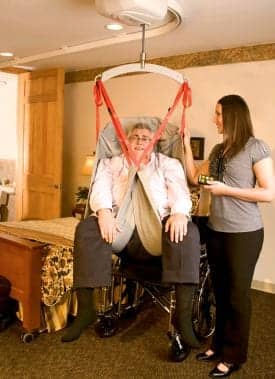
Home evaluations consider existing conditions and recommend specific changes, such as using walkers or installing rails, ramps, or chair lifts.
When seniors choose to age at home, changes in their physical and functional abilities are inevitable and can sometimes lead to a crisis. Fulfilling the goal of helping seniors age at home safely requires more than simply responding to a crisis. Professionals must employ a proactive team approach that can anticipate needs and provide for rehabilitation and care services at all stages of need.
The best approach to effective planning comes from leveraging the expertise of a multidisciplinary group of professionals to establish a care team. The basic questions that will ultimately set the direction of interventions to create a healthy at-home environment, consistent with the seniors’ needs, values, and preferences, include:
- What is important to the senior and how do they feel about residing at home?
- If changes occur in the senior’s physical capabilities, how willing will the senior be in adapting their home (eg, building ramps or widening doors)?
- Would the senior agree to a new living plan such as moving from the second floor to the first floor?
- Is there adequate space for caregiving staff if required?
- How would technology or smart devices enhance home life?
- With adaptations, devices, and/or equipment, how can the home remain a home and not take on the feel of a “facility”?
From this initial assessment, care managers strive to understand the importance of the senior’s home environment, while at the same time identifying key risk factors that may adversely affect safety and quality of life.
Care managers assess clinical, physical, and psychological conditions that can impact a senior’s ability to function independently at home. Rehabilitation professionals and their teams can benefit from understanding these conditions and their symptoms in order to create the most sustainable plans for the seniors with whom they work. With this understanding, rehabilitation professionals can additionally mitigate potential resistance and perceived trauma associated with change. Working collaboratively, seniors can live safely, comfortably, and as autonomously as possible.
ORTHOPEDIC CHALLENGES
One of the greatest threats to a senior’s independence is an injury to their bones resulting from a fall. A senior who previously enjoyed a high level of independence may suddenly become immobile or suffer a gradual decline in ability post-hospitalization. Upon returning home, an older adult may avoid excessive use of therapeutic exercises due to pain, depression, and/or lack of professional guidance.
At this juncture, rehabilitation professionals can offer great value to seniors and their families in multiple ways.
First, they can initiate a home safety evaluation and actively implement any necessary environmental changes to help alleviate risk of future falls, such as:
- Uneven surfaces, loose rugs/carpeting, or slick floors
- Loose wires traversing common walkways
- Excessive clutter or objects blocking normal pathways or halls
- Unruly pets that move or dart about unpredictably or with great force
- Poor lighting
Evaluations can reveal concrete tasks to improve the physical environment. Perhaps a grab bar or banister needs to be installed near a stairway or the lighting changed at the entry. Clutter, which in most instances means stacks of books, magazines, and newspapers or storage boxes left on the floor or in hallways, can cause stumbling and falls. Disposing of trash and removing stacks of debris create safe pathways through hallways and around corners.
The creation of a dedicated “rehab” space can help motivate the older adult to consistently exercise, thus building strength to prevent falls and other dangerous incidents while keeping the home space organized in a user-friendly, functional way. A single chair with arms located in one area can be sufficient for strength exercises. A basement or spare bedroom can be transformed into a dedicated exercise space.
Regardless of the chosen space, it is best to avoid choosing an area with high-pile carpeting, opting instead for an area with a hard surface.
Next, collaboration with other care team members, such as those listed below, is critical to ensure the senior’s safety:
- The physician for effective pain, disease/medical conditions, and medication management.
- The care manager to procure appropriate caregiving staff that can assist seniors with their exercises in a consistent manner, along with activities of daily living, and the coordination of all needed community-based psychosocial services.
- Allied rehabilitation colleagues as needed: physical, occupational, and speech therapists; nutritionists; nurses; wound care specialists; etc.
CHRONIC MEDICAL CONDITIONS
Senior adults often have chronic medical conditions that affect mobility, even if the senior’s health remains relatively sound. Some of these conditions include diabetes, blood pressure problems, heart disease, arthritis, and Parkinson’s disease. Each causes mobility problems in different ways:
- Diabetes causes neuropathies and imbalance as well as weakness and vision problems.
- Low blood pressure affects balance and gait stability.
- Heart conditions cause weakness, endurance, and gait stability issues.
- Multiple sclerosis causes weakness and affects endurance and gait stability.
- Parkinson’s affects gait stability and balance.
- Arthritis results in pain, which can lead to gait instability.
In these cases, specialized rehabilitation support helps prevent further injury and minimizes future risk by first conducting a safety evaluation. The evaluation considers existing conditions and recommends specific changes such as using walkers or installing rails, ramps, or chair lifts.
Considerations to be aware of at the outset include:
- A wide variety of assisted devices are available such as walkers, wheelchairs, and more.
- The physical and cognitive ability of seniors drives the selection process. For example, seniors with full mental function may simply need assistance with balance. On the other hand, a senior with dementia may not benefit from using devices because of a lack of cognitive ability to manage them.
- For walking, front-wheeled walkers and rolling walkers with a seat make ideal choices.
When considering ramps or railings, it is important to think about permanent installations and to hire a qualified contractor. Unfortunately, when temporary installations are completed by helpful neighbors or friends, the results may not be ideal. Professionals understand the height, ratio, and strength requirements so that the installation is appropriate and durable.
It is well known that an individual’s physical health is connected to emotional well-being. Therefore, it is important to evaluate the general state of a senior’s mood and emotional health. Medications (and the potential for adverse reactions) can also contribute to fall risks when taken in combination with other medications. Furthermore, fear of falling can negatively impact a senior’s gait stability. Working in collaboration with one another allows rehab professionals to best understand the contributing factors that put a senior at higher risk for a fall.
Since aging affects not only seniors, but also the involved family caregivers, providing education and support to family members can help create a positive, healthy atmosphere for older adults to achieve their rehab goals.
BATHROOM SAFETY

Use of a 3:1 commode can be an important consideration for bathroom safety in this key functional area of the home.
Two primary features impacting in this key, functional area of the home are access and lighting. Accidents occur when either is inadequate.
First, wheelchairs and walkers can make mobility a challenge in small areas. Install off-set door hinges, which can increase door clearance. Other practical considerations include removing throw rugs and creating nonskid surfaces such as a bath mat in the tub or shower, installing handheld showers or grab bars, and using a raised toilet with rails or a 3:1 commode.
As discussed earlier, lighting also needs to be adequate and appropriately placed.
HEARING AND VISION AND FALL RISK
Failing eyesight and hearing can affect a senior’s ability to process surrounding visual and auditory cues that contribute to and potentially heighten an individual’s fall risk. One cause of failing eyesight among the senior population is macular degeneration, which can cause falls in the home if an individual affected by the condition cannot see objects in their path.
This situation can be addressed by the efforts of a multidisciplinary team that includes a physical therapist, an occupational therapist, an ophthalmologist, an audiologist, and a geriatric care manager. The physicians conduct a medical evaluation of eyes and ears and an OT and PT conduct a home safety evaluation to assess the level of clutter, appropriate devices for assistance, and the need for additional visual devices, improved lighting, and an emergency response system. Specifically, the team:
- Evaluates not only the need for prescription eyeglasses but the possibility of magnifying or reader glasses, a closed circuit reader system, books on tape, and a new larger reading tablet.
- Assesses the physical lighting in the area. Often, just relocating lamps can help to eliminate shadows—which many seniors can’t distinguish from objects.
- Recommends floor lamps that provide more direct light and installs incandescent bulbs with at least 40 watts.
With the advances to increase safety in personal emergency response systems, seniors have many options. These systems, designed to alert others about a change in habit or movement, can be installed by a caregiver or family member because they offer “plug and play” simplicity. Many are now equipped with GPS to monitor any wanderers in addition to reporting if a senior has fallen. Systems with these functions can be found and purchased online.
When a senior’s ability to drive is challenged, an outpatient OT driving evaluation program in the community can help determine their driving capabilities. If needed, a care manager can identify alternative transportation resources and assess the need for additional care within the home.
MOVING FORWARD
Conducting home assessments and understanding conditions common to senior adults living at home establish a baseline for care needs, allowing specialists to begin tracking progress or recommend further changes for family or in-home caregivers. Working closely together, professionals from all fields can build a healthy home environment that allows seniors to age in place with grace and dignity.
Steve Barlam, Chief Professional Officer of LivHOME, LCSW, cofounded LivHOME in 1999 with Mike Nicholson, Chief Executive Officer. Since 1984, Barlam has worked exclusively in the field of geriatric care management. Both a Certified Care Manager and Licensed Clinical Social Worker, Barlam has an extensive background in the field of geriatric care management. Past president of the National Association of Professional Geriatric Care Managers, he is actively involved in the professional credentialing process for care managers through his involvement with the National Academy of Certified Care Managers.
Gary King, CMC, is a Care Manager for LivHOME in Walnut Creek, Calif, and has over 25 years of experience in hospital management. Before coming to LivHOME, he worked as a Clinical Coordinator with Rehab Without Walls and Private Duty Care Manager for elderly clients, managing their medical and rehab care needs. Care management for seniors with chronic pain, CVA/strokes/TBI, and spinal cord injury is among his many areas of expertise. For more information, contact .





